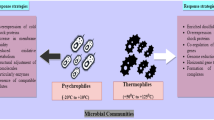Summary
The effects of mercury pollution on the allozymic variation of 15 phosphoglucomutase (PGM) genotypes was tested in the Mediterranean shrimpPalaemon elegans in 79 laboratory tests involving 2765 shrimps, with 1560 survivors (767 test and 793 control). Our results indicate differential tolerance of genotypes in variable mercury concentrations, suggesting that they are adaptive. The genetic structure can possibly be explored and potentially be used as a monitoring system for the quality and quantity of marine pollutants.
Similar content being viewed by others
Literatur
E. Nevo, Theor. Pop. Biol.13, 121 (1978).
M. Kimura, Scient. Am.241, 98 (1979).
L.B. Holthuis and E. Gottlieb, Bull. Res. Counc. Israel7B, 1 (1958).
M. Tsurnamal, Israel J. Zool.12, 117 (1963).
E. Nevo, T. Perl, A. Beiles, D. Wool and U. Zoller, ICSEM/UNEP workshop on pollution of the Mediterranean. Cagliari, Italy, 9–13 October 1980; Journées Etud. Pollutions, p. 61–68, Cagliari, C.I.E.S.M. (1980). Likewise, all details are available upon writing to the authors.
R.K. Selander, M.H. Smith, S.Y. Yang, W.E. Johnson and G.B. Gentry, Univ. Tex. Publs7103, 49 (1971).
S. Siegel, Nonparametric statistics for the behavioral sciences. McGraw Hill, New York 1956.
S. Yanai and K. Sachs, Environm. Res.16, 408 (1978).
Mercury content in our control and test shrimps was determined by the method of cold vapor flameless atomic absorption spectrophotometry, at the laboratory of Prof. Yanai, Department of Food Engineering and Biotechnology, Technion-Israel Institute of Technology, Haifa. Control animals had 0.08 ppm total mercury. Shrimps that remained alive after 24 h aquaria at 0.04 ppm HgCl2 had 1.40 ppm, and those that remained alive more than 24 h at 0.40 ppm HgCl2 contained in their bodies 4.62 ppm total mercury.
It is likely that differential inhibition of PGM allozymes by mercury is the mechanism involved; see inhibition of PGM by mercury in Milstein, C. Biochem. J.79, 591 (1961).
Author information
Authors and Affiliations
Additional information
Acknowledgments. This research was supported by grants from FAO/UNEP, The United States-Israel Binational Science Foundation (BSF), Jerusalem, Israel, the Motzkin family and the Israel Electric Corporation. We thank Uri Zoller for technical advice and P. Hertz for reading and commenting on the manuscript. — D. Wool is working at Tel Aviv University.
Rights and permissions
About this article
Cite this article
Nevo, E., Perl, T., Beiles, A. et al. Mercury selection of allozyme genotypes in shrimps. Experientia 37, 1152–1154 (1981). https://doi.org/10.1007/BF01989890
Published:
Issue Date:
DOI: https://doi.org/10.1007/BF01989890




